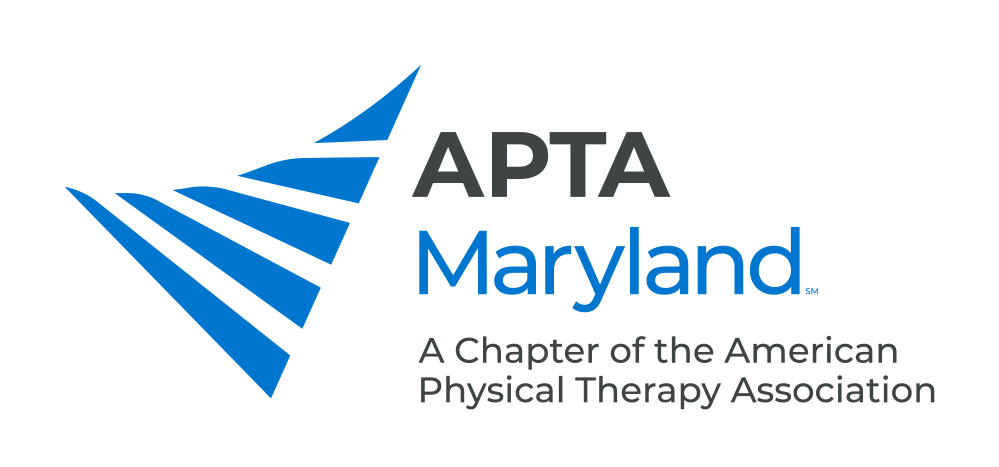Mission & History
Mission
APTA Maryland fosters excellence in the profession of physical therapy by advocating, educating, and promoting best practices to improve the human experience of the diverse society we represent and serve.
Vision
Transforming the diverse communities in Maryland to advance health and wellness by optimizing movement and function across the lifespan.
Historical Highlights of the APTA of Maryland
1930’s
In April of 1937, there were 7 members-at-large in Maryland. In May 1939, with 11 members in attendance, an organizational meeting was held and the following officers were elected: President, Florence Kendall; Vice-president, Alphild Johnson; Secretary, Jane Ewing; Treasurer, Dorothy Luebber. The officers were appointed as a committee to draw up a constitution for the chapter. In November 1939, 24 signed as charter members, formally organizing the Maryland Chapter.
1940’s
The early forties were the war years and at least a third of the members joined the Army. By the mid-forties, the chapter was deeply involved with matters of legislation. The Maryland State Board of Physical Therapy Examiners was created by the Legislature in 1947.
It consisted of 3 medical doctors and two physical therapists one representing (essentially) the APTA group and one representing a group outside the APTA. Due to problems that arose in connection with the latter group, the Board had to be reconstituted at the next biennial session of the Legislature in 1949. Five medical doctors were appointed to the Board.
In 1947, the chiropractors had succeeded in getting an exclusion clause in the physical therapy bill that enabled them to include physical therapy in their practice as chiropractors according to the definition in the Physical Therapy Practice Act. Note: In March of 1945, the chapter raised the local dues from $1.00 to $2.00, and, from donations, the legislative fund had a balance of $32.42. Salaries, including one meal, varied from $2,000 for the new PT to $2,300 for the experienced PT.
1950’s
The American Registry of Physical Therapy Technicians was organized by the American Congress of Physical Therapy (later called the American Congress of Physical Medicine and Rehabilitation). Problems arose in regard to the Regulations and code of Ethics of the Registry during the early 50’s, continued throughout the 60’s, and until the Registry dissolved in December 1971.
1960’s
In 1965, the Physical Therapy Practice Act was amended to add two physical therapists to the five physician members of the Board of Examiners. In 1967, an amendment was added which revised the definition (essentially as it appears in the 90’s) and defined the practice, not just the words physical therapy. It was probably the best definition among the states which had licensure for PTs.
1970’s
In 1973, physical therapist assistants were licensed; in 1974, an amendment provided for a Board of Physical Therapy Examiners composed of physical therapists when the terms expired for the two physicians still on the Board. In 1978, occupational therapists were licensed without the requirement for physician referral, a move that set the stage for physical therapists to obtain direct access in 1979, one of the first states to accomplish this.
1980’s & 1990’s
Emphasis was placed on legislation, reimbursement, expanding member programs and services, and enhancing the management of the Chapter. The Chapter became an effective advocate before the Maryland General Assembly regarding issues that affect the physical therapy profession. A legislative effort was waged to prohibit referral for profit, i.e., prohibiting physicians from owning physical therapy services and referring patients to same. The Chapter also developed important working relationships with other health care associations to work in collaboration to address common health care issues.
APTA of Maryland, Inc. became pro-active in the reimbursement arena, established valuable relationships with insurance companies, and provided essential education and training services to members regarding reimbursement issues affected by health care reform. With the increased demand for the delivery of quality members programs and services, the Chapter hired its first full-time Executive Director in 1991. Legal Counsel with background in health care issues, Legislative Counsel to handle lobbying matters, a Certified Public Accountant, and a Public Relations Consultant were put on retainer.
The Chapter’s governance documents were overhauled, and an improved governing structure was established. The first executive director for the chapter was hired on a part-time basis in the late 1980's.
2000's
In 2008, The Chapter hired a new executive director to help centralize the work of the chapter, grow membership, and enhance services and support for members. In 2009 the Chapter launched a new web site, developed new marketing initiaives and brochures on referral for profit and direct access and began the development of a new student committee. Legislative focus areas included animal rehab, athletic trainer licensure, referral for profit, and defeating bills that would have required direct supervision of PTAs and that would have licensed personal trainers under the Dept. of Health and Mental Hygiene.
2010
In 2010 a formal request from the Acupuncturist board on the ability of PTs to perform dry needling and other invasive procedures was initated which then launched the chapter into a six year effort along with the Maryland Board of Examiners and chapter members to protect the right of PTs to do dry needling in our state. In 2015 legislation was introduced and finally withdrawn through the efforts of the Chapter and members to continue our right to perform dry needling.
The Chapter has been fortunate to have leaders with vision who have prepared us for the 21st century.


